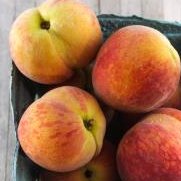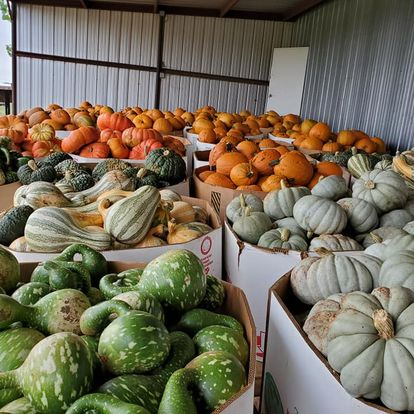Producer


Livesay Orchards
Contact: Kent and Steve Livesay
Address: 39232 E 231st St Porter, OK, 74454
Phone: 918-483-2102
Website: LivesayOrchards.com
About Us
Livesay Orchards near Porter, Oklahoma, is owned and farmed by brothers Kent and Steve Livesay. Both have degrees in agriculture from Oklahoma State University. The orchard was started by Austin Livesay, a great uncle of Kent & Steve. With more than 140 acres of peach trees, Livesay is the largest peach orchard in the state. There are also 10 acres of apples, 30 acres of watermelons and cantaloupes, 30 acres of pumpkins and gourds, tomatoes and sweet corn. Livesay operates a large, open air Farm Market on the farm, and about 60% of the peach harvest is sold directly to the public from the market. The market also sells other fresh fruit and vegetables, along with other Porter Peach Products.
Practices
Our family farm is a regenerative agriculture and sustainability focused
conventional farm. There are two main components to our focus:
economic/financial sustainability and environmental sustainability.
Farming in Oklahoma is a contest of survival against unpredictable
weather events and difficult pests (insects, nematodes, weeds, bacteria,
and fungus). The climate in Oklahoma is quite conducive to many pests
unlike more desert climates where there is less rainfall and lower
humidity, which both lead to lower pest pressures. To compete against
those problems we have to make decisions on how best to care for our
crops. This means deciding when we have reached an economic threshold
(ET) where allowing a pest to continue to harm our crop will affect the
short term economic/financial sustainability of our farm. From there we
can start determining what the available options are and what their
likely impact would be on environmental sustainability of our farm. The
environmental sustainability of the farm is directly linked as well to
the long term economic/financial sustainability because a short-sighted
focus of growing our crops could lead to a deterioration of the growing
environment on the farm.
Could we grow our crops without any attempt to control or mitigate
pests? Some crops would be dead or decimated before reaching harvest and
most of the ones that did reach harvest would have an unmarketable
product due to the unchecked spread of plant diseases and insects. This
would of course fail the economic/financial sustainability as our farm
cannot exist without marketable crops. Does this mean that our only
method to protect our crops is through plant protection products
(commonly referred to as pesticides)? No, in fact plant protection
products are more of a last resort. There is an old phrase from Benjamin
Franklin that “an ounce of prevention is worth a pound of cure” and for
farming an ounce of pest prevention is monumentally more economical than
a pound of cure. From the start we give the plants the best chance at
survival through what is called integrated pest management (IPM).
-We look for cultivars that are known to be more resistant to pests.
-We rotate crops so as to not give the pests another host plant in that
same location.
-We plant most of our annual fruit and vegetable crops with a weed
barrier which, by reducing weed competition, will make the plants more
likely to shrug off insect or disease damage.
-We try to eliminate pest habitat in or near the field by keeping areas
mowed or by pruning in such a way that pests are less likely to find the
plants as a desirable habitat.
-We also remove and destroy diseased plants or plant limbs to prevent
the spread of the pest.
-When we do use plant protection products we try to find ones that are
targeted just at the pest species so that there is less disruption to
beneficial plants, insects, or mites.
All of the above work to reduce the amount of plant protection products
needed because the plants will be healthier from the start.
In short, we take a thoughtful, science-based approach to farming that
prioritizes both the health of our crops and the long-term vitality of
our land. Our practices reflect a deep commitment to sustainability
through integrated pest management, careful decision-making, a mix of
time-tested and modern practices to grow healthy crops in a way that’s
good for our farm and the environment. Our goal is to grow high-quality,
delicious produce in a way that protects the environment, supports our
family business, and ensures that Livesay Orchards can keep providing
fresh fruit to families for generations to come.
conventional farm. There are two main components to our focus:
economic/financial sustainability and environmental sustainability.
Farming in Oklahoma is a contest of survival against unpredictable
weather events and difficult pests (insects, nematodes, weeds, bacteria,
and fungus). The climate in Oklahoma is quite conducive to many pests
unlike more desert climates where there is less rainfall and lower
humidity, which both lead to lower pest pressures. To compete against
those problems we have to make decisions on how best to care for our
crops. This means deciding when we have reached an economic threshold
(ET) where allowing a pest to continue to harm our crop will affect the
short term economic/financial sustainability of our farm. From there we
can start determining what the available options are and what their
likely impact would be on environmental sustainability of our farm. The
environmental sustainability of the farm is directly linked as well to
the long term economic/financial sustainability because a short-sighted
focus of growing our crops could lead to a deterioration of the growing
environment on the farm.
Could we grow our crops without any attempt to control or mitigate
pests? Some crops would be dead or decimated before reaching harvest and
most of the ones that did reach harvest would have an unmarketable
product due to the unchecked spread of plant diseases and insects. This
would of course fail the economic/financial sustainability as our farm
cannot exist without marketable crops. Does this mean that our only
method to protect our crops is through plant protection products
(commonly referred to as pesticides)? No, in fact plant protection
products are more of a last resort. There is an old phrase from Benjamin
Franklin that “an ounce of prevention is worth a pound of cure” and for
farming an ounce of pest prevention is monumentally more economical than
a pound of cure. From the start we give the plants the best chance at
survival through what is called integrated pest management (IPM).
-We look for cultivars that are known to be more resistant to pests.
-We rotate crops so as to not give the pests another host plant in that
same location.
-We plant most of our annual fruit and vegetable crops with a weed
barrier which, by reducing weed competition, will make the plants more
likely to shrug off insect or disease damage.
-We try to eliminate pest habitat in or near the field by keeping areas
mowed or by pruning in such a way that pests are less likely to find the
plants as a desirable habitat.
-We also remove and destroy diseased plants or plant limbs to prevent
the spread of the pest.
-When we do use plant protection products we try to find ones that are
targeted just at the pest species so that there is less disruption to
beneficial plants, insects, or mites.
All of the above work to reduce the amount of plant protection products
needed because the plants will be healthier from the start.
In short, we take a thoughtful, science-based approach to farming that
prioritizes both the health of our crops and the long-term vitality of
our land. Our practices reflect a deep commitment to sustainability
through integrated pest management, careful decision-making, a mix of
time-tested and modern practices to grow healthy crops in a way that’s
good for our farm and the environment. Our goal is to grow high-quality,
delicious produce in a way that protects the environment, supports our
family business, and ensures that Livesay Orchards can keep providing
fresh fruit to families for generations to come.
